Tectonic Wedging in the California Coast
Ranges: Useful Model or an Unreasonable Hypothesis?
Maureen Berlin
GEOL 5690, Tectonics of the Western U.S., Fall 2005
Rocks in California (Figure 1) record a long history of
subduction during the Mesozoic and early Cenozoic, followed by strike-slip
offsets along the San Andreas fault system during the late Cenozoic. This
Andean-type continental margin (Figure 2) produced an arc-trench system
with corresponding arc volcanism, forearc deposition, and subduction and
accretion of terranes.

Figure
1. California, showing place names, geologic provinces, and selected
geologic units. From Fuis and Mooney 1990.
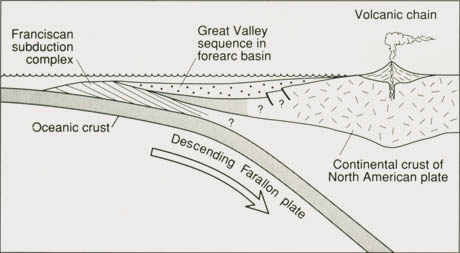
Figure
2 . Schematic diagram showing California as an Andean-type continental
margin during late Mesozoic time (from Wallace 1990, modified from Dickinson
1981).
The history of Cenozoic deformation in the Franciscan subduction
complex has been the subject of considerable debate. Various workers have
assembled information on the surficial geology, structures at depth, and
other constraints based on seismic, magnetic field, and gravity data. As
a result, a variety of different tectonic models have been proposed for
the California Coast Ranges and Great Valley forearc basin (Figure 3).
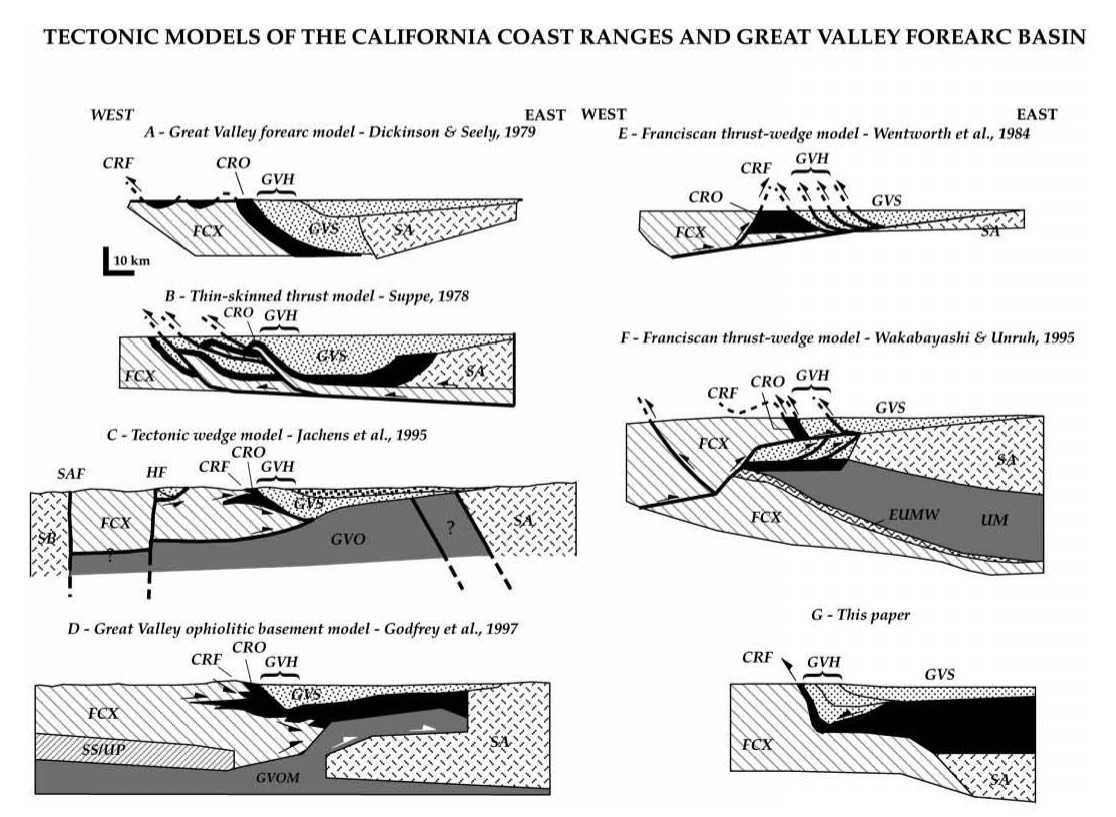
Figure
3 . Montage of tectonic models of the Great
Valley forearc basin and Coast Range subduction complex. Rock unit
abbreviations: CRF—Coast Range fault; CRO—Jurassic Coast
Range ophiolite; EUMW—extended upper mantle wedge; FCX—Cretaceous
Franciscan Complex; GVH—Great Valley monocline; GVO—Great
Valley ophiolite; GVOM—Great Valley ophiolite mantle; GVS—Upper
Jurassic -Cretaceous Great Valley Group; HF—Hayward fault; SA—Sierran
arc; SAF—San Andreas fault; SB—Salinian block; SS/UP—stalled
slab/underplate; UM—upper mantle [from Constenius et al. 2000
("This paper" in G refers to Constenius et al. 2000), including
figures modified from Ring and Brandon, 1994].
A key point of contention seems to be whether or not tectonic
wedging can adequately inform geotectonic interpretations. Tectonic wedging
has been a preferred model for interpretations of tectonic relations along
the Great Valley flank of the California Coast Ranges. This model was derived
from inferred structural relations at Coalinga near the geologic boundary
between the California Coast Ranges and the Great Valley. Tectonic wedging
has been succinctly described by Davis et al. (1983), and refers to tectonic
behavior that is amenable to being modeled as a Coulomb or critical-taper
wedge taper, which thins in the direction of motion:
"The overall mechanics of fold-and-thrust
belts and accretionary wedges along compressive plate boundaries is
considered to be analogous to that of a wedge soil or snow in front
of a moving bulldozer. The material within the wedge deforms until a
critical taper is attained, after which it slides stably, continuing
to grow at constant taper as additional material is encountered at the
toe. The critical taper is the shape for which the wedge is on the verge
of failure under horizontal compression everywhere, including the basal
decollement."
This website summarizes the regional
geology, reviews general theories of tectonic
wedging, and presents an overview of the history of Coast Range tectonic
interpretation, including arguments for and against tectonic wedging
in the California Coast Ranges. For a list of references, click here.
1.
REGIONAL GEOLOGY
Figure 4 illustrates the position of important rock
groups in California, in particular the Coast Range ophiolite, the Franciscan
complex, and the Great Valley Group. The differences in these rocks (e.g.
density, magnetic properties, and seismic velocities) are important in understanding
the subsurface structure, which in turn is necessary for developing a model
for past and current tectonic activity in the region.
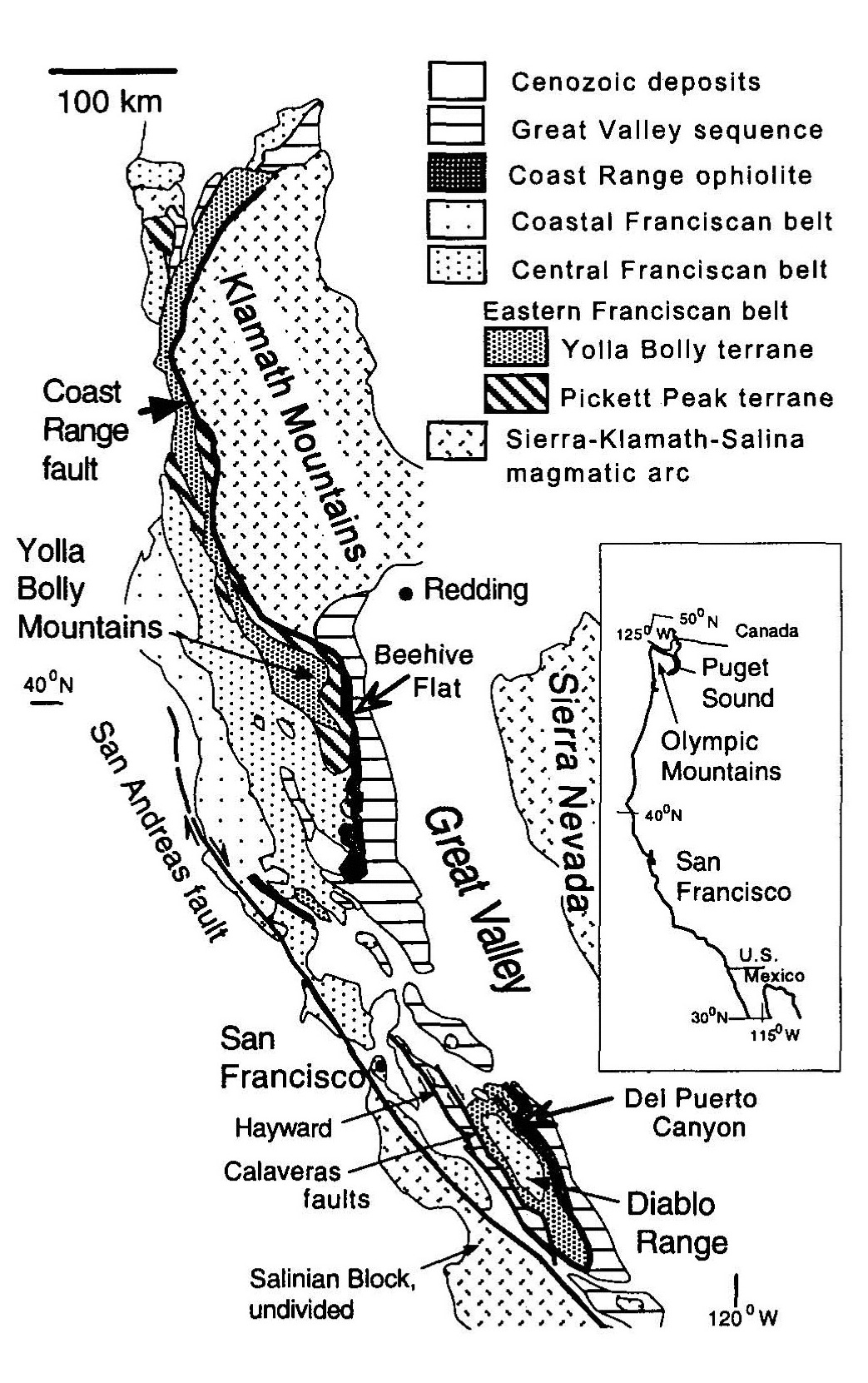
Figure
4.
Geologic map showing main Mesozoic tectonic elements of western California.
Rocks of interest are the Coast Range ophiolite, the Franciscan complex,
and the Great Valley Group. From Ring and Brandon (1994).
Before we get to the specific characteristics of these rocks,
let's summarize the events that led to their location in western California.
Much of this summary is presented in Wakabayashi and Unruh (1995).
170–150 Ma:
-Coast Range ophiolite emplaced. This is thought to be induced
by mantle upwelling linked to lithospheric extension, but the origin of
the ophiolite is controversial. Dickinson and others (1996) provide a summary
of current theories on ophiolite emplacement based on various lithospheric
spreading hypotheses.
165–130 Ma:
-East-dipping Franciscan subduction began at around 165 Ma, resulting
in accretion and metamorphism of Franciscan complex terranes, including
blueschist facies (Wakabayashi and Unruh 1995).
-Deposition of the Great Valley Group on oceanic crust of the Coast Range
ophiolite also began during this time period, coincident with the early
stages of Franciscan subduction (Dickinson and Seely 1979, as cited in Wakabayashi
and Unruh 1995).
-A basal Great Valley sequence of late Jurassic age was deposited
on the Coast Range ophiolite (Bailey, Blake, and Jones 1970, as cited in
Wentworth et al. 1984.), although in most places the contact is faulted.
130–120 Ma:
-Contractional deformation associated with east-vergent thrust faulting
in the Great Valley Group began (Unruh et al. 1995). This deformation coincides
with the beginning of contraction in the Sevier belt in the Great Basin
(Allmendinger 1992, as cited in Wakabayashi and Unruh 1995).
120–100 Ma:
-Contractional deformation ends, and forearc basin sediments are
deposited on deformed lower Great Valley Group strata [Unruh et al. 1995,
Moxon 1988 (as cited in Wakabayashi and Unruh 1995)].
100–70 Ma:
-Accretion of oceanic terranes in the Franciscan Complex (e.g.,
Marin Headlands, Geysers) (Murchey and Blake 1993, as cited in Wakabayashi
and Unruh 1995). Metamorphism of blueschist facies continues, while some
blueschists are uplifted along normal faults (Platt 1986, Jayko et al. 1987).
70 Ma–Present:
-Shortening in the Great Valley Group coincident with accretion
of the coastal belt of the Franciscan complex (Moxon 1988, as cited in Wakabayashi
and Unruh 1995).
-Onset of tectonic wedging that has continued episodically throughout the
Cenozoic (Wakabayashi and Unruh 1995), although this point is debatable.
The properties of rock groups in our region of interest are important factors
in characterizing the subsurface structure. Below is a brief summary of the
different lithologies present in each group.
Coast Range ophiolite: middle to upper Jurassic oceanic
crust: serpentine, gabbro, and basaltic volcanic rocks (Figure 5) (Hopson
et al. 1981, as cited in Platt 1986). Ophiolitic breccias locally overlying
the Coast Range ophiolite and resting beneath the Great Valley Group reflect
extensional deformation at the sites of their construction (Robertson 1990,
as cited in Dickinson et al. 1996).
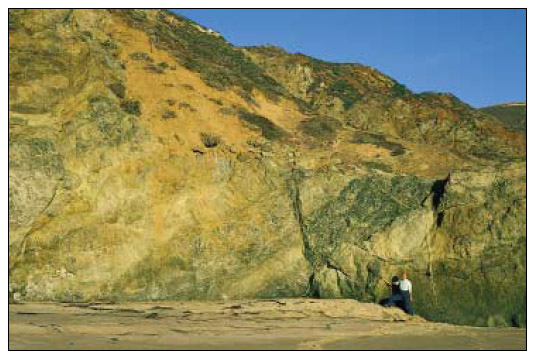
Figure
5.
Multiple basaltic sills of the sheeted dike and sill complex, Point Sal
remnant of the Middle Jurassic Coast Range ophiolite. The ridge in background
exposes sheeted sills and (to left of tree on the skyline) base of the
overlying pillow lavas. From Dickinson et al (1996).
Franciscan complex: zonation in age, metamorphic grade
(Figure 6), and structural style. Blake and Jones (1981) distinguish three
major belts in the northern Californian Coast Ranges:
- Coastal Belt: relatively coherent graywackes of Late Cretaceous
to Eocene age (McLaughlin et al. 1982, as cited in Platt 1986), showing
mainly zeolite-facies metamorphism (low temperature, low pressure) (Ernst
1971, as cited in Platt 1986).
- Central Belt: extensive tracts of clay-matrix melange (Maxwell
1974, Cloos 1982, both as cited in Platt 1986), and metamorphic mineral
assemblages include pumpellyite and lawsonite (Blake et al. 1967, as cited
in Platt 1986). Blocks of high-grade metamorphic rocks including blueschist,
eclogite, and amphibolite are locally abundant.
- Eastern Belt: coherent slabs with distinct differences in metamorphic
grade (lawsonite-albite, blueschist, and greenschist facies), suggesting
present contacts postdate the high-pressure peak of metamorphism (Suppe
1973, as cited in Platt 1986).

Figure
6.
Metamorphic facies phase diagram.
Great Valley Group: consists primarily of mudstone intercalated
with sandstone and conglomerate lenses. Made up of submarine-fan, basin-plain,
slop, and submarine-canyon sediments deposited in a north-south-trending
forearc basin (Robertson 1990, Ingersoll 1979, 1982, Ingersoll and Dickinson
1981, Brown and Rich 1967, Suchecki 1984, Williams et al. 1998; all as cited
in Constenius et al. 2000)
2.
TECTONIC WEDGING THEORY
Tectonic wedging has been succinctly described by Davis et al. (1983):
"The overall mechanics of fold-and-thrust belts
and accretionary wedges along compressive plate boundaries is considered
to be analogous to that of a wedge soil or snow in front of a moving bulldozer.
The material within the wedge deforms until a critical taper is attained,
after which it slides stably, continuing to grow at constant taper as
additional material is encountered at the toe. The critical taper is the
shape for which the wedge is on the verge of failure under horizontal
compression everywhere, including the basal decollement."
"Tectonic wedging" refers to tectonic behavior that
is amenable to being modeled as a Coulomb or critical-taper wedge taper, which
thins in the direction of motion (Figure 7). The basic idea is that slight
variations in surface slope (alpha) and basal slope (beta) from critical values
(based on wedge strength and other factors such as pore pressure) will lead
to a tectonic response that brings the system back into a stable state.
Figure
7.
Schematic diagram of a critical-taper wedge, from Craig Jones, Fold and
Thrust Belts and Orogenic Wedges handout.
The following derivation of a wedge taper expression is
from Craig Jones' Fold and Thrust Belts and Orogenic Wedges handout. If
we consider the force balance in the x direction on the shaded
region of width dx in Figure 7, we can write the expression:

If we assume that the frictional resistance is about
equal to the weight times the coefficient of friction, then:

We can approximate the normal stress parallel to
x as sigma1 from the Coulomb failure criterion for a rectangular
block, adjusting for the angle of z from the vertical:

After applying some simple geometric relationships
and using small angle approximations, we can write an expression
describing wedge taper, based upon both basal and intrinsic (e.g.,
pore pressure) parameters:

Platt (1986) conducted stability modeling to
predict patterns of deformation in an accretionary wedge resulting from externally
imposed changes in its geometry (Figures 8a-d). Frontal accretion refers to
the accumulation of material at the tip of the wedge. Because this accreted
material lengthens the wedge, alpha will be low in the frontal region, which
will therefore be in compression. If the longitudinal stresses are large enough,
internal shortening via out-of-sequence thrusting will occur. Underplating
is the mechanism by which material is accreted to the underside of the wedge,
after it has traveled down the basal decollement some distance.
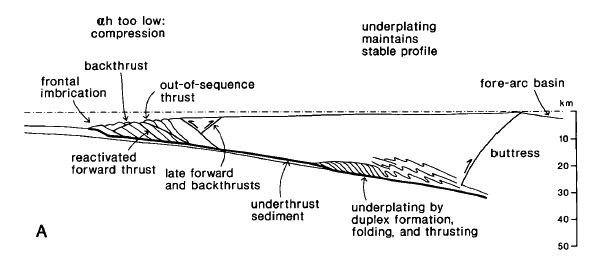
Figure
8a.
Early-stage model of an accretionary wedge, from Platt (1986). Frontal
accretion is dominant, and alpha is too low in the frontal region, which
therefore shortens internally.
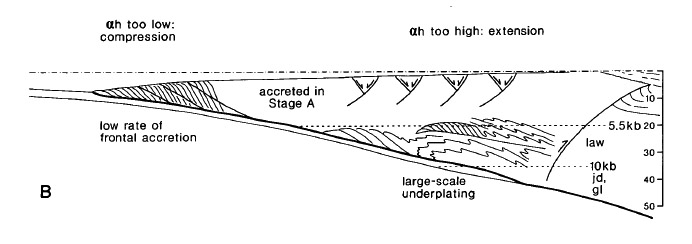
Figure
8b.
Alpha is high in the rear of the wedge, which extends by normal faulting
and possibly by ductile flow at depth. The deeper parts of the wedge undergo
high P/T-ratio metamorphism. From Platt (1986).

Figure
8c.
Continued underplating and resultant extension have lifted high-pressure
rocks toward the surface. Extension at the rear of the wedge causes lateral
movement of material and late thrusting toward the prism front. From Platt
(1986).

Figure
8d.
In a mature wedge, underplating and extension have brought high-pressure
rocks to within 15 km of the surface, accessible to future erosion. The
wedge has lengthened and the uplifted rocks in the rear of the wedge will
have several generations of accretionary structures overprinted by multistage
normal faults. From Platt (1986).
3. PROPOSED
TECTONIC MODELS
Below is a brief summary of various studies on tectonic wedging in the Coast
Ranges. I have tried to highlight the methods of the research wherever possible;
however, many of these papers are heavy on interpretation. Papers are presented
in chronological order as an attempt to discern the history of thought on this
subject.
- Much of the early work on the tectonics in western California centered around
the structural relation between the Franciscan assemblage and the adjacent
Great Valley group. The two units were thought to be juxtaposed by a major
thrust, the Coast Range thrust. Bailey, Blake, and Jones (1970, as cited in
Wentworth et al. 1984) placed the Coast Range thrust at the base of the Coast
Range ophiolite and described it as a subduction zone suture along which the
Franciscan assemblage had been thrust eastward beneath the Coast Range ophiolite
and overlying Great Valley sequence.
- In 1981, the USGS began a project using deep seismic reflection profiling
and detailed refraction surveys to trace the Coast Range thrust eastward to
depth. Initial results presented by Wentworth et al. (1983, as cited in Wentworth
et al. 1984) suggested that tectonic wedging, rather than subduction, seems
to be the dominant tectonic style at the east margin of the Franciscan assemblage.
- Wentworth et al. (1984) used seismic reflection and refraction profiles
to determine the velocity structure under the Great Valley. An abrupt structural
change occurs across the boundary between the California Coast Ranges and
the Great Valley. Beneath the valley, a regional unconformity on crystalline
rock dips gently westward and reaches depths of 5-10 km at the west side of
the valley. In the Coast Ranges, Jurassic and Cretaceous Great Valley sequence
strata stand nearly on edge and dip steeply east toward the valley. The western,
basal boundary of these upturned strata abuts the Franciscan assemblage, separated
by as much as 5 km of Coast Range ophiolite (Figure 9). This subsurface structure
is similar over 4 degrees of latitude representing much of the length of the
Great Valley.
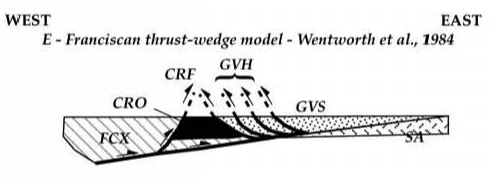
Figure
9.
Schematic cross section of the Great Valley forearc basin and Coast Range
subduction complex, from Constenius et al. (2000), modified from Wentworth
et al. (1984). Tectonic wedges described by Wentworth et al. (1984) are
present in the area delineated as the Great Valley monocline (GVH).
- Wentworth et al. (1984) interpret the seismic data to indicate that an eastward-thinning
wedge of rock of intermediate seismic velocity lies between fast, crystalline
basement and slower, overlying Great Valley sequence. Mostly because of its
seismic velocity (5.6–5.8 km/s), this wedge was inferred to be Franciscan
rocks. They assumed that tectonic wedging is the dominant style of deformation,
and that the Coast Range Thrust is not a fossil subduction thrust, but was
originally a roof thrust of the eastward-thinning Franciscan wedge.
- Platt (1986) conducted stability modeling of orogenic wedges
and proposed that the uplift of high-pressure Franciscan rocks can be explained
by underplating and resultant extension causing stretching of the mantle wedge
(Figure 10). Platt's model predicts a westward thinning wedge, which
is different from the wedges inferred by Wentworth and others.
Figure
10.
Tectonic evolution of the Franciscan Complex, California, from Platt (1986).
(a) Early Cretaceous: high pressure/low temperature metamorphism took
place in sediment subducted beneath the Coast Range ophiolite and underlying
mantle wedge. (b) Early Tertiary: underplating and resultant extension
stretched the mantle wedge together with the ophiolite and Great Valley
rocks. Note present-day erosion level reflects removal of a significant
portion of the upper surface.
- Fuis and Mooney (1990) reinterpreted the tectonic wedge of Franciscan rocks
to extend from its tip beneath the Great Valley all the way to the San Andreas
fault. This interpretation was motivated by the apparent continuity between
crystalline basement rocks beneath the Great Valley and mafic rocks at mid
crustal depths in the Diablo Range, beneath the Franciscan rocks. They argue
for the following tectonic evolution for the wedge:
(1) Franciscan rocks were uplifted and rocks above the subduction zone
were extended during the Cretaceous (or, possibly, early Tertiary) well
west of their current position in the Coast Ranges.
(2) The Franciscan rocks and overlying extended crust were subsequently
forced landward during one or more episodes in the form of a wedge that
largely followed the contact between Great Valley basement and the Great
Valley sequence.
(3) Wedge movement began during the subduction of the Farallon plate (or
its derivative) beneath central California; however, it apparently is also
occurring at present, in the San Andreas transform regime. Present movement
is interpreted to result from compression across the San Andreas fault system
coupled with differential motion between the upper and lower crust; this
differential motion is interpreted to occur on thrust fault(s) at the base
of the wedge that sole into the brittle-ductile transition zone.
- Ring and Brandon (1994) inferred overall brittle strain
from slickensides in the Coast Range fault zone. Their data indicate fault-parallel
contraction (Figure 11), which is inconsistent with the extension proposed
by Platt (1986). The observed attenuated metamorphic section with high-pressure
metamorphic rocks of the eastern Franciscan juxtaposed against low-pressure
rocks in the overlying structural lid does not require extensional faulting.
Rather, out-of-sequence thrust faults can cause attenuation of a section if
the section dips more steeply than the faults (Figure 12). Ring and Brandon
propose that exhumation of material was accomplished by erosion of an emergent
wedge, and that observed out-of-sequence thrust faults are consistent with
either backthrusting via a wedging model (e.g. Wentworth et al. 1984), or
forward thrusting via thin-skinned deformation (e.g. Suppe 1979).
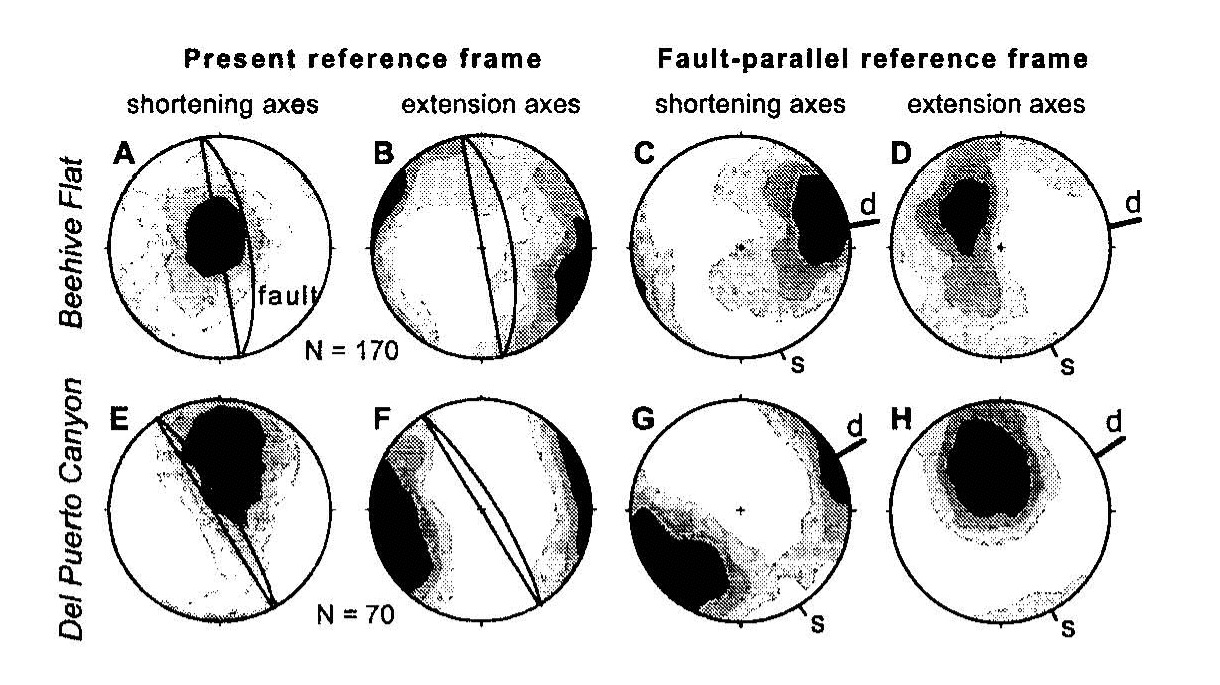
Figure
11. Contoured
maximum-shortening and maximum-extension axes for brittle strain at Beehive
Flat and Del Puerto Canyon (see Figure 3, above). Regional strike, s,
and down-dip direction, d, of fault zone are shown.
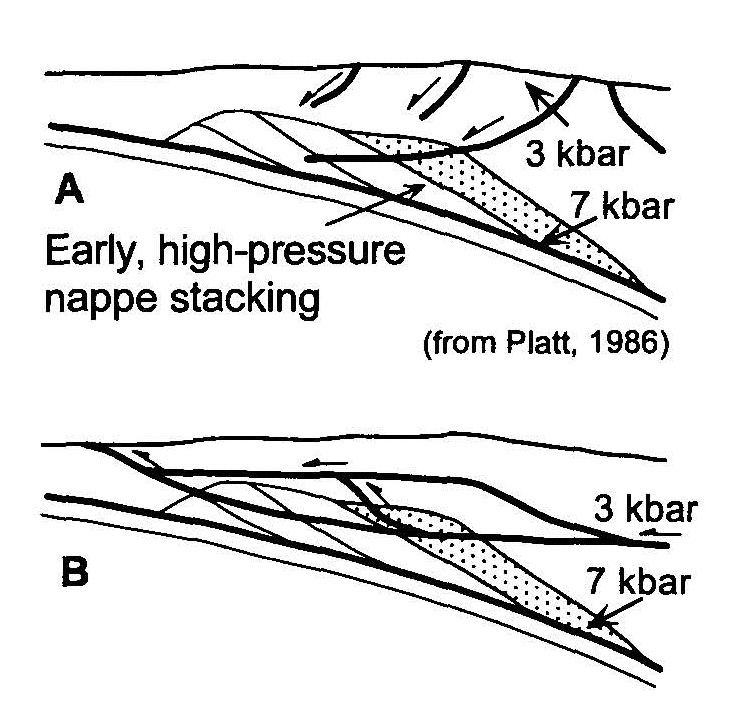
Figure
12. Illustration
of metamorphic break due to superimposed (a) normal faults or (b) out-of-sequence
thrust faults, from Ring and Brandon (1994).
- Jachens et al. (1995) compiled and reprocessed data from
airborne magnetometer surveys in order to calibrate their model for the depth
of basement rocks below the Great Valley (Figure 13). Magnetic anomaly analysis
is an effective tool for investigating the subsurface structure because ophiolitic
rocks and serpentinite associated with the Franciscan assemblage carry strong
magnetization in contrast to sedimentary layers of the Great Valley Group
and Franciscan complex, which are assumed to be nonmagnetic (Wallace 1990).
- A specific magnetic profile surveyed by Griscom and Jachens (1990, as
cited in Jachens et al. 1995) was selected to coincide with seismic reflection
(Wentworth and Zoback 1990, as cited in Jachens et al. 1995) and refraction
(Walter 1990, as cited in Jachens et al. 1995) surveys. Inferred basement
depths from these different methods agreed well, supporting the use of magnetic
methods.
- After analyzing data from several cross-sections across the Great Valley,
authors point to the presence of a smoothly westward tapering basement block
whose west dipping upper surface is the top of the Great Valley crystalline
basement, which extends 30-50 km west of the surface trace of the Coast
Range fault.
- The authors use the westward extent of the Great Valley basement (Figure
14) to support the idea that a thick wedge of the Franciscan
Complex traveled east along the base of the Great Valley and peeled up strata
of varying ages.
a. 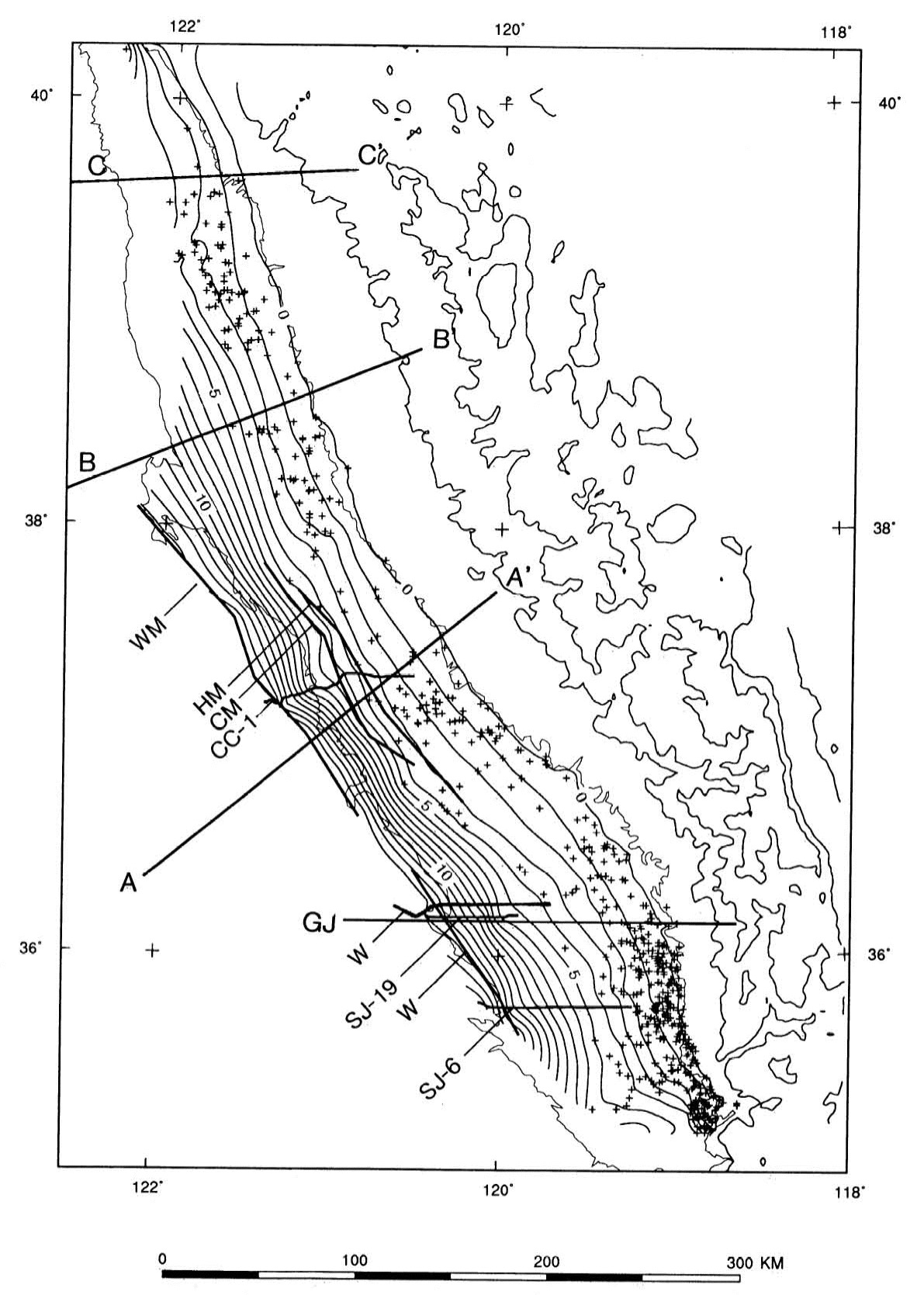 b.
b. 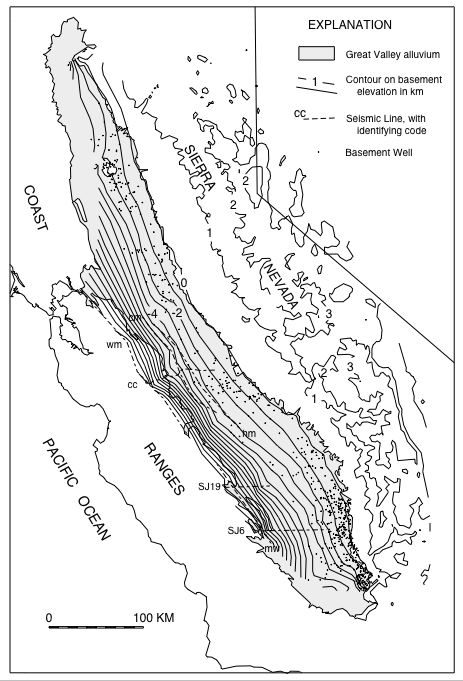
Figure
13.
(a) Map of contours on top of crystalline basement in central California
[from Jachens et al. (1995) after Wentworth et al. (1995)]. Note locations
of seismic reflection and refraction profiles, as well as profiles along
which magnetic models were constructed. (b) Summary map of basement surface
contours, wells, and seismic lines, central California. Figure from Wentworth
et al. (1995) to provide location context to (a).
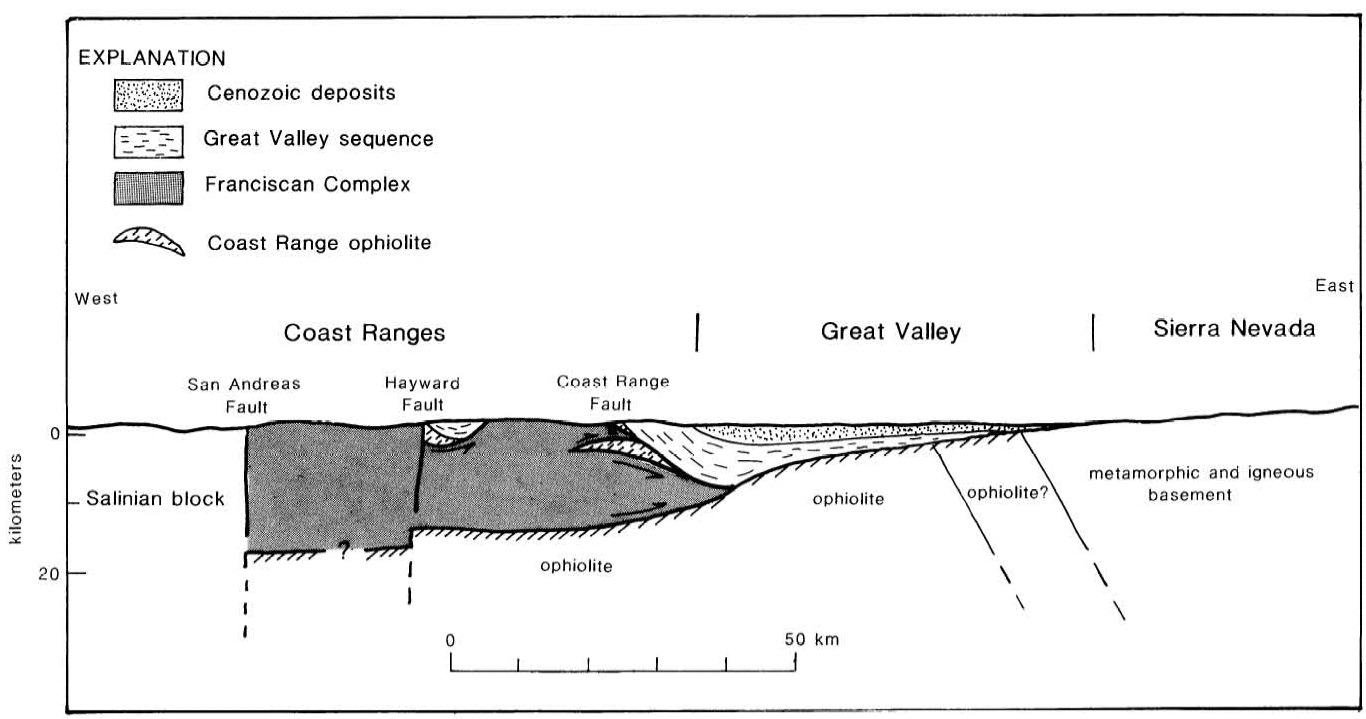
Figure
14.
Schematic crustal section across the Great Valley and Coast Ranges of California
based on geophysical interpretation by Jachens et al. (1995). Arrows indicate
direction of movement of Franciscan wedge relative to adjacent materials.
Note that multiple stages of wedging are implied by rocks of the Franciscan
Complex structurally both above and below the slab of Coast Range ophiolite
located beneath the trace of the Coast Range Fault.
- Wakabayashi and Unruh (1995) presented an interpretation that attempts to
resolve the relative timing of wedging and blueschist metamorphism and also
present reasonable geometries of trench and fore-arc deformation that are
compatible with geologic observables (Figure 15). They conclude that tectonic
wedging does occur, but that the geometry and kinematics of the wedging cannot
account for significant uplift of blueschists.
Wakabayashi and Unruh (1995) argue against the out-of-sequence thrusting argument
proposed by Ring and Brandon (1994), saying that their model requires the
erosion of all crustal material above the blueschists in the Franciscan complex,
and that a large volume of ultramafic material should be exposed. The composition
of Great Valley Group and Franciscan complex sandstones and conglomerates
do not reflect an ultramafic source rock, suggesting the blueschists were
not exposed.
The authors make an interesting connection to the Laramide orogeny, by suggesting
that flat-slab subduction may have increased coupling in the fore-arc area,
promoting contraction of the Great Valley basin. Accretion of the Franciscan
coastal belt at the same time would have decreased the wedge taper and perhaps
triggered shortening in the wedge [as Platt (1986) would suggest].
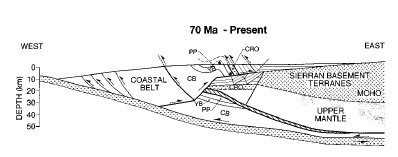
a. 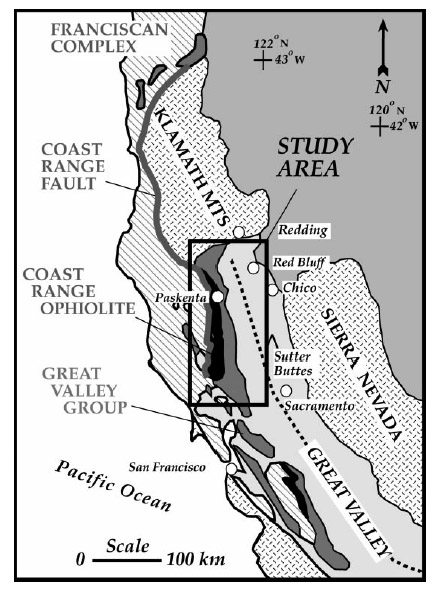 b.
b. 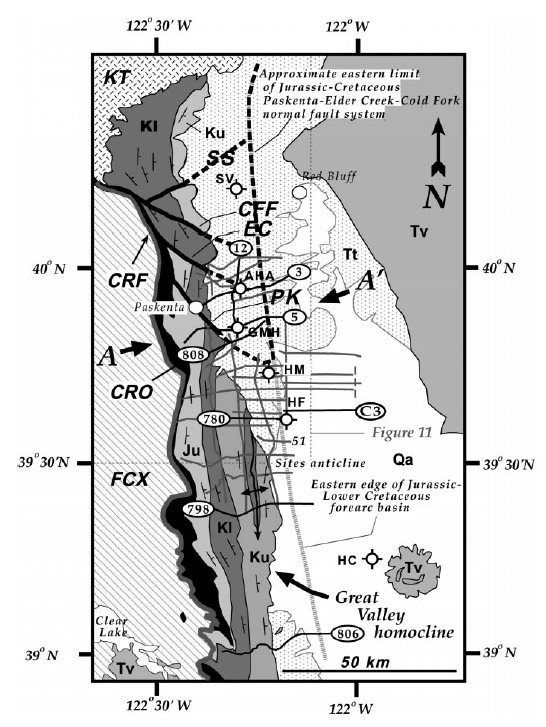
Figure
16.
(a) Index map showing relationship of Constenius et al. (2000) study area
to elements of Great Valley and Coast Ranges. Axis of Great Valley magnetic
and gravity high is shown as dashed line. (b) Geologic index map of the
northern Great Valley showing seismic profiles and wells. From Constenius
et al. (2000).
The authors suggest that imbricate thrust features, typically
associated with tectonic wedging, are actually relict constructional patterns
formed during deposition (Figure 17). The inactive nature of these features
provides support for the lack of tectonic wedging in the Coast Range region.
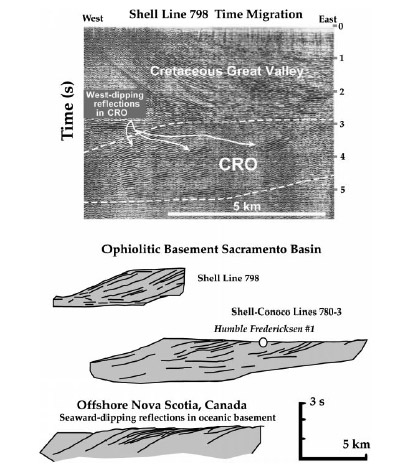
Figure
17.
Patterns of seismic reflectivity from the ophiolitic basement of the Sacramento
basin compared with volcanic margins of the Atlantic Ocean basin. Constenius
et al. proposed that the Coast Range ophiolite reflections, based on their
west-dipping shingled geometry, are the products of interlayered volcanic
flows, volcaniclastic rocks, and mafic intrusions similar to those beneath
volcanic rifted margins. From Constenius et al. (2000).
Figure 18 is an example of a seismic profile used by Constenius
et al. (2000) to assess the geometry of structures at depth. The authors interpret
a complicated convergence of seismic reflections to indicate a fork-shaped
pattern of reflectivity. This fork structure indicates a combination of syndepositional
normal faulting and stratal onlap along the flank of the evolving Great Valley
forearc basin, rather than postdepositional thrust wedging.
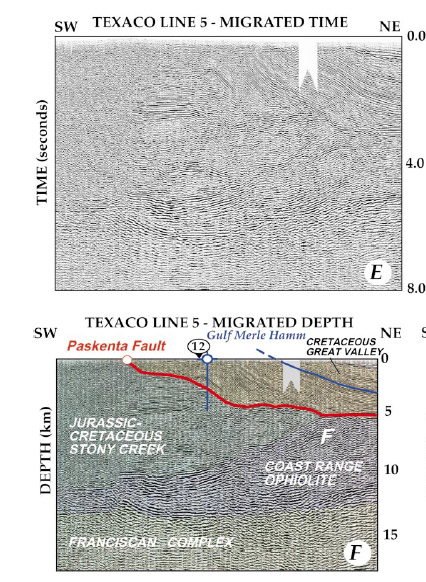
Figure
18.
(e) Migrated time seismic profile TX 5 from the northwestern Sacramento
basin that images the Paskenta and Elder Creek fault zones, Cretaceous
discontinuity, and ophiolitic basement. (f) Depth-converted section
with interpreted units. F indicates location of fork structure. From
Constenius et al. (2000).
Figure 19 summarizes the authors' interpretation of subsurface
structure, which was confirmed by their Bouguer gravity model. Bouguer gravity
modeling was conducted to assess the subsurface continuity of the Coast Range
ophiolite and to establish the geometry of the Franciscan Complex beneath
the ophiolite. Working within the constraints determined by the seismic reflection
profiles, borehole data, and regional geophysical results of Godfrey et al.
(1997), the authors experimented with crustal structures and densities that
would match the gravity data. Gravity highs occur over layered rocks of the
Franciscan assemblage, particularly in areas containing large amounts of mafic
volcanic rocks (generally part of an ophiolite belt) or high-pressure metamorphic-mineral
facies (Wallace 1990). Most of the deepest lows are caused by thick accumulations
of low-density Cenozoic sedimentary rocks (Wallace 1990).
Constenius et al. (2000) conclude that the "tectonic wedging" model
is only a viable mechanism if it is restricted to crustal material beneath
the Coast Range ophiolite, and that it cannot explain more shallow faulting.
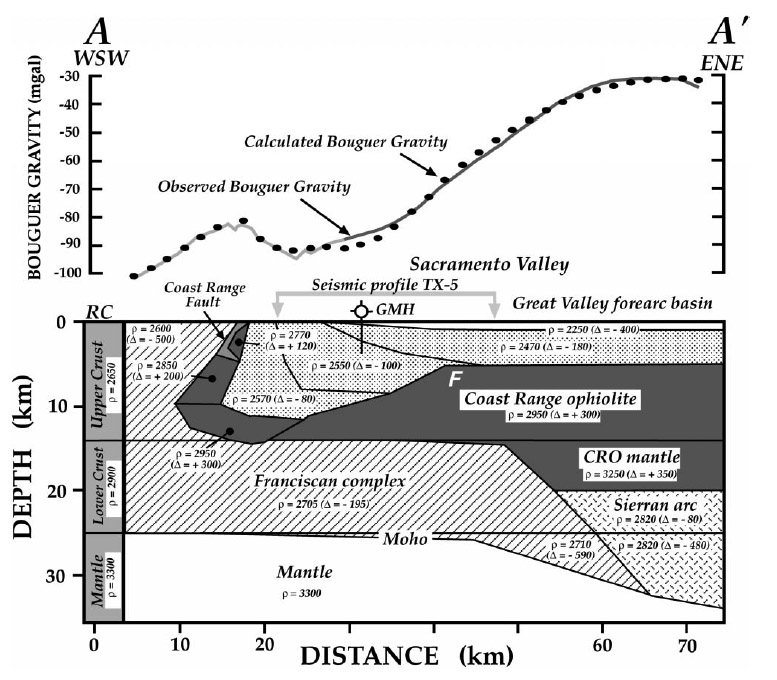
Figure
19. Geologic cross section and Bouguer gravity models of the
Great Valley monocline based on regional seismic refraction and gravity
results of Godfrey et al. (1997), detailed Bouguer gravity models (Ruppel
1971), interpretation of seismic reflection profile TX 5, borehole data,
and surface mapping by Maxwell (1974). F indicates location of fork structure.
RC is the generalized reference column for densities of crust and upper
mantle. From Constenius et al. (2000).
- Dickinson (2002) interpreted seismic profiles across the Coalinga
anticline (Figure 20) and correlated the character and orientation of
seismic reflectors with surface geology. He concluded that a Franciscan
thrust wedge was not required by any data, and was apparently incompatible
with exposed rocks updip from the seismic reflectors inferred to represent
Franciscan rocks.
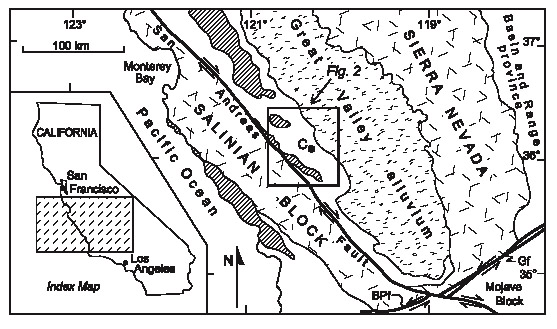
Figure
20. Location of Coalinga (C) at eastern flank of California
Coast Ranges in relation to major tectonic elements of central California.
From Dickinson (2002).
Dickinson (2002) contrasts alternate interpretations of seismic data
with and without a Franciscan thrust wedge (Figure 21). If the inferred
upper surface of the Franciscan wedge (Figure 21a) is projected directly
updip, its trace emerges at the surface though a continuous section
of the Great Valley Group. To maintain the idea of a Franciscan thrust
wedge beneath the core of the Coalinga anticline, it is necessary to
postulate the presence of a gently dipping thrust surface at comparatively
shallow depth beneath the full 15-km span of the exposed Great Valley
Group. No analogous structure has been mapped, suggesting that the thrust
wedge model is unreasonable.
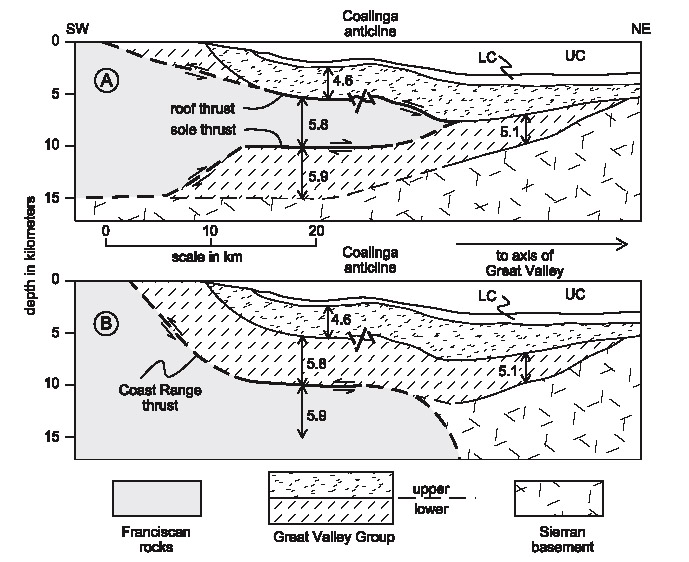
Figure
21. Alternate interpretations of USGS seismic line SJ-19:
(a) with Franciscan thrust wedge and (b) without Franciscan thrust
wedge. Numbers within section indicate mean seismic interval velocities.
From
Dickinson (2002).
- Unruh et al. (2004) used seismic reflection profiles to suggest that ophiolitic
fragments were incorporated by attenuational processes, not thrust wedging.
Figure 22 shows the locations of seismic profiles used in their study.
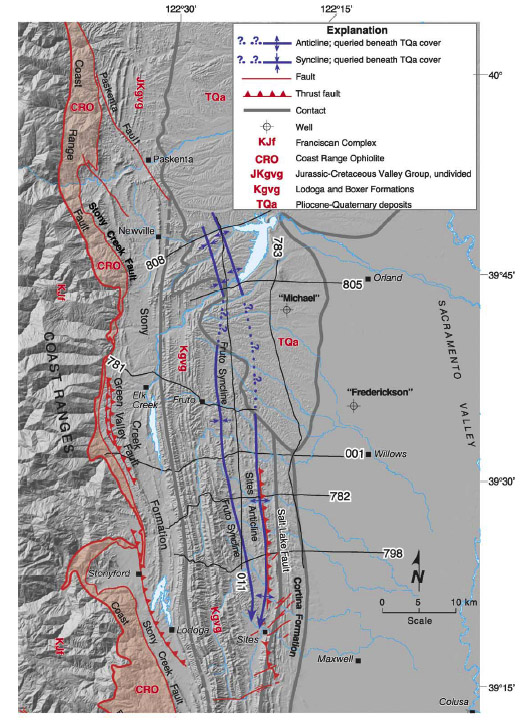
Figure
22. Simplified geologic map of the northwestern Sacramento Valley
study area showing locations of 2-D seismic reflection profiles. From
Unruh et al. (2004).
Unruh et al. (2004) disagree with the interpretation that east-dipping
reflectors imaged in seismic profiles (Figure 23) represent ophiolitic fragments
that were incorporated primarily by tectonic wedging, because thrust-related
deformation thickens the crust, whereas both map and subsurface relationships
indicate that blueschist-grade rocks of the Franciscan complex are in structural
contact with relatively shallow upper crustal rocks, indicating net crustal
attenuation (Jayko et al., 1987). Unruh et al. (2004) favor the alternative
hypothesis that the magnetic bodies underlying the western outcrops of Great
Valley Group strata are fragments of ophiolitic crust and mantle that were
mixed with the Franciscan rocks by attenuational processes rather than thrust
wedging (Jayko and Blake, 1986; Jayko et al., 1987).
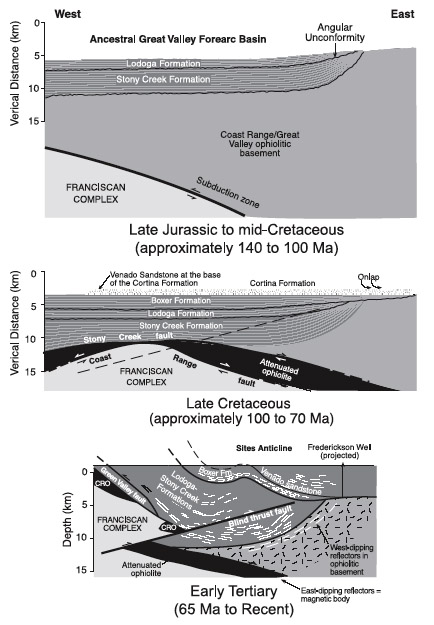
Figure
23. Line-length and area-balanced forward model for the development
of structures interpreted in seismic line 001 (see Figure 22 for location
of line 001). From Unruh et al. (2004).
- Ring and Richter (2004) conducted a strain and rotation analysis to test
for mylonitic extensional structures in the Franciscan complex. Their results
provide no support for large-scale horizontal extension, at least in the
Del Puerto Canyon in the Diablo Range. Low strain rates suggest that ductile
flow was not fast enough to form a supercritically tapered Franciscan wedge.
CONCLUSIONS?
Recent studies (Constenius et al. 2000, Dickinson 2002, Ring and Richter
2004) have argued against a tectonic wedging model for late Cenozoic deformation
of the Coast Ranges. That these studies use more modern geophysical tools
than previous work suggests that the popularity of tectonic wedging may
be faltering. It seems that more integration of the literature is needed
in order to come to a consensus. Also, although some workers (Wentworth
et al. 1984, Constenius et al. 2000, Jachens et al. 1995) present data and
interpretation for large areas, a lot of studies are highly localized and
therefore make extrapolation to the entire N-S extent of the Coast Ranges
and Great Valley highly difficult.
4. REFERENCES
Allmendinger, R. W., 1992, Fold and thrust tectonics of the
western United States exclusive of the accreted terranes, in Burchfiel, B. C.,
et al., eds., The Cordilleran orogen: Conterminous U.S.: Boulder, Colorado,
Geological Society of America, Geology of North America, v. G-3, p. 583–607.Bailey,
E. H., Blake, M. C. Jr., and Jones, D. L. 1970. On-land Mesozoic oceanic crust
in Californian Coast Ranges. USGS Professional Paper 700-C, p. C70-C81.
Blake, M. C., Irwin, W. P., and Coleman, R. B. 1967. Upside-down
metamorphic zonation, blueschist facies, along a regional thrust in California
and Oregon. USGS Professional Paper 575C, p. 1-9.
Blake, M. C., and Jones, D. L. 1981. The Franciscan assemblage
and related rocks in northern California: a reinterpretation. In Ernst, W. G.,
ed. The geotectonic development of California. Englewood Cliffs, New Jersey,
Prentice-Hall, p. 307-328.
Brown, R.D., Jr., and Rich, E.I., 1967, Implications of two Cretaceous mass
transport deposits, Sacramento Valley, California: Comment on a paper by Gary
L. Peterson: Journal of Sedimentary Petrology, v. 37, p. 240–248.
Cloos, M. 1982. Flow melanges: Numerical modeling and geologic constraints
on their origin in the Franciscan subduction complex, California. Geol. Soc.
of Amer. Bull. v. 93, p. 330-345.
Constenius, K. N., Johnson, R. A., Dickinson, W. R., and T.
A. Williams. 2000. Tectonic evolution of the Jurassic-Cretaceous Great Valley
forearc, California: Implications for the Franciscan thrust-wedge hypothesis.
GSA Bulletin v. 112, no. 11. p. 1703-1723. November.
Davis, D., Suppe, J., and F. A. Dahlen. 1983. Mechanics of fold-and-thrust
belts and accretionary wedges. Journal of Geophysical Research v. 88, no. B2,
p. 1153-1172.
Dickinson, W. R. 1981. Plate tectonic evolution of the southern Cordillera.
In: Relations of tectonics to ore deposits in the southern Cordillera. Arizona
Geological Society Digest, 14: 113-135.
Dickinson, W.R., 2002. Reappraisal of hypothetical thrust wedging at Coalinga:
implications for tectonic relations along the Great Valley flank of the California
Coast Ranges. Tectonics 21, 3-1– 3-14.
Dickinson, W. R., Hopson, C. A., and J. B. Saleeby. 1996. Alternate
origins of the Coast Range ophiolite (California): introduction and implications.
GSA Today v. 6, no.2. p. 1-10. February 1996.
Dickinson, W. R. and Seely, D. R. 1979. Structure and stratigraphy
of forearc regions. American Association of Petroleum Geologists Bulletin, v.
63, p. 2-31.
Ernst, W. G. 1971. Metamorphic zonations on presumably subducted
lithospheric slabs from Japan, California, and the Alps. Contributions to Mineralogy
and Petrology, v. 34, p. 43-59.
Fuis, G. S. and W. D. Mooney. 1990. Lithospheric structure and
tectonics from seismic-refraction and other data. In: Wallace, R. E. 1990. The
San Andreas fault system, California. U.S. Geological Survey Professional Paper:
1515. Online at: http://education.usgs.gov/california/pp1515/copyright.html.
Viewed December 2005.
Godfrey, N. J., B. C. Beaudoin, and S. L. Klemperer. 1997. Ophiolitic basement
to the Great Valley forearc basin, California, from seismic and gravity data:
Implications for crustal growth at the North American continental margin, Geol.
Soc. Am. Bull., 109, 1536 – 1562.
Griscom, A. and R. C. Jachens. 1990. Tectonic implications of
gravity and magnetic models along east-west seismic profiles along the Great
Valley near Coalinga. In: The Coalinga, California Earthquake of May 2, 1983.
Ed: M. J. Rymer and W. L. Ellsworth. USGS Professional Paper 1487, p. 69-78.
Hopson, C. A., Mattinson, J. M., and Pessagno, E. A. 1981. Coast
Range ophiolite, western California. In Ernst, W. G., ed., The geotectonic
development of California. Englewood Cliffs, New Jersey, Prentice-Hall, p. 418-510.
Ingersoll, R.V., 1979, Evolution of the Late Cretaceous forearc basin, northern
and central California: Geological Society of America Bulletin, v. 90, p. 813–826.
Ingersoll, R.V., 1982, Initiation and evolution of the Great Valley forearc
basin of northern and central California, in Leggett, J.K., ed., Trench-forearc
geology: Sedimentation
and tectonics on modern and ancient active plate margins: Geological Society
[London] Special Publication 10, p. 459–467.
Ingersoll, R.V., and Dickinson, W.R., 1981, Great Valley Group (sequence),
Sacramento Valley, California, in Frizzell, V., ed., Upper Mesozoic Franciscan
rocks and Great Valley sequence, central Coast Ranges, California: Annual Meeting
Field Trips 1 and 4: Pacific Section, Society of Economic Paleontologists and
Mineralogists, p. 1–33.
Jachens, R. C., Griscom, A., and C. W. Roberts. 1995. Regional
extent of Great Valley basement west of the Great Valley, California: Implications
for extensive tectonic wedging in the California Coast Ranges. Journal of Geophysical
Research v. 100, no. B7, p. 12,769-12,790. July 10, 1995.
Jayko, A.S., Blake Jr., M.C. 1986. Significance of Klamath rocks between the
Franciscan complex and Coast Range ophiolite, northern California. Tectonics
5, 1055– 1071.
Jayko, A.S., Blake, M.C., Jr., and Harms, T. 1987. Attenuation of the Coast
Range Ophiolite by extensional faulting, and the nature of the Coast Range ‘‘thrust,’’
California: Tectonics, v. 6, p. 475–488.
Maxwell, J. C. 1974. Anatomy of an orogen. Geological Society of America Bulletin,
v. 85, p. 1195-1204.
McLaughlin, R. J., Kling, S. A., Poore, R. Z., McDougall, K.,
and Beutner, E. C. 1982. Post-middle Miocene accretion of Franciscan rocks,
northwest California. Geological Society of America Bulletin v. 93, p. 595-605.
Murchey, B. L., and Blake, M. C., Jr., 1993, Evidence for subduction of a major
ocean plate along the California margin during the Middle to early Late Jurassic,
in Dunne, G., and McDougall, K., eds., Mesozoic paleogeography of the western
United States, II: Pacific Section, Society of Economic Paleontologists and
Mineralogists, Book 71, p. 1–18.
Moxon, I. W., 1988, Sequence stratigraphy of the Great Valley basin in the
context of convergent margin tectonics, in Graham, S. A., ed., Studies of the
geology of the San Joaquin Basin: Pacific Section, Society of Economic Paleontologists
and Mineralogists, Field Trip Guidebook 60, p. 3–28.
Platt, J. P. 1986. Dynamics of orogenic wedges and the uplift
of high-pressure metamorphic rocks. Geol. Soc. Am. Bull., 97, 1037 – 1053.
Ring, U. and M. T. Brandon. 1994. Kinematic data for the Coast
Range fault and implications for exhumation of the Franciscan subduction complex.
Geology v. 22, p. 735-738.
Ring, U. and P. P. Richter. 2004. Normal faulting at convergent
plate boundaries: Mylonitic extensional fabrics in the Franciscan subduction
complex in Del Puerto Canyon, California, revisited. Tectonics, Vol. 23,
Robertson, A. H. F. 1990. Sedimentology and tectonic implications
of ophiolite-derived clastics overlying the Jurassic Coast Range Ophiolite,
northern California. American Journal of Science v. 290, p. 109-163.
Ruppel, B.D. 1971. Geophysics of the Great Valley–Franciscan junction
between Paskenta and Stony Ford, California: Geological Society of America Bulletin,
v. 82, p. 1717–1722.
Suchecki, R.K., 1984, Facies history of the Upper Jurassic– Lower Cretaceous
Great Valley sequence: Response to structural development of an outer-arc basin:
Journal of Sedimentary Petrology, v. 54, p. 170–191.
Suppe, J. 1973. Geology of the Leech Lake Mountain-Ball Mountain region, California:
A cross-section of the northeastern Franciscan belt and its tectonic implications.
University of California Publications in Geological Sciences, v. 107, 82 p.
Suppe, J. 1979. Structural interpretation of the southern part
of the northern Coast Ranges and Sacramento Valley, California: Summary. Geological
Society of American Bulletin, v. 90, p. 327-330.
Unruh, J., O'Connell, D., and L. V. Block. 2004. Crustal structure
of the ancestral northwestern California forearc region from seismic reflection
imaging: implications for convergent margin tectonics. Tectonophysics 392, p.
219-240.
Unruh, J. R., B. A. Loewen, and E. M. Moores. 1995. Progressive
arcward contraction of a Mesozoic-Tertiary fore-arc basin, southwestern Sacramento
Valley, California, Geol. Soc. Am. Bull., 107, 38 – 53.
Wakabayashi, J. and Unruh J. R. 1995. Tectonic wedging, blueschist
metamorphism, and exposure of blueschists: Are they compatible? Geology 23 (1):
85-88 Jan 1995.
Wallace, R. E. 1990. The San Andreas fault system, California.
U.S. Geological Survey Professional Paper: 1515. Online at: http://education.usgs.gov/california/pp1515/copyright.html.
Viewed December 2005.
Walter, A. W. 1990. Upper-crustal velocity structure near Coalinga, as determined
from seismic-refraction data. In: The Coalinga, California Earthquake
of May 2, 1983. Ed: M. J. Rymer and W. L. Ellsworth. USGS Professional Paper
1487, p. 23-40.
Wentworth, C. M., Blake, M. C. Jr., Jones, D. L., Walter, A.
W., and Zoback, M. D. 1984. Tectonic wedging associated with emplacement of
the Franciscan assemblage, California Coast Ranges. In Blake, M.C., ed., Franciscan
geology of northern California. Pacific Section, Society of Economic Paleontologists
and Mineralogists, Field Trip Guidebook 43, p. 163-173.
Wentworth, C. M., Fisher, G. R., Levine, P. and R. C. Jachens.
1995. The surface of crystalline basement, Great Valley and Sierra Nevada, California:
a digital map database. USGS Open File Report 95-96.
Wentworth, C. M., Walter, A. W., Zoback, M. D., and Blake,
M. C., Jr. 1983. Possible obduction of Franciscan assemblage, southeasternmost
Diablo Range, California (abs.). American Geophysical Union, Transactions, EOS
v. 64, no. 45, p. 868.
Wentworth, C. M. and M. D. Zoback. 1990. Structure of the Coalinga region and
thrust origin of the earthquake. In: The Coalinga, California
Earthquake of May 2, 1983. Ed: M. J. Rymer and W. L. Ellsworth. USGS Professional
Paper 1487, p. 41-68.
Williams, T.A., Graham, S.A., and Constenius, K.N. 1998. Recognition of a Santonian
submarine canyon, Great Valley Group, Sacramento basin, California: Implications
for petroleum exploration and sequence stratigraphy of deep-marine strata: American
Association of Petroleum Geologists Bulletin, v. 82, p. 1575–1595.






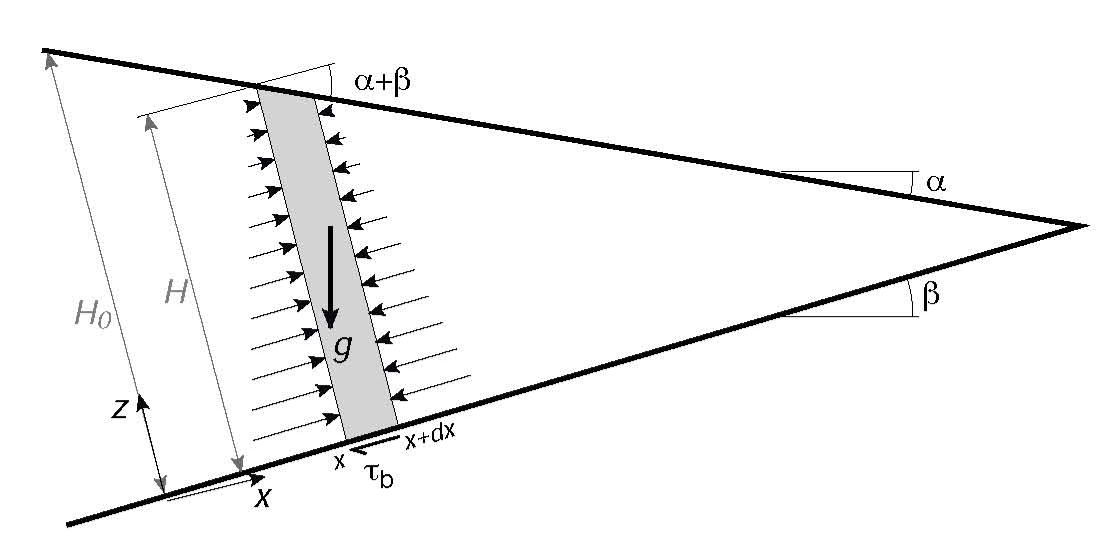








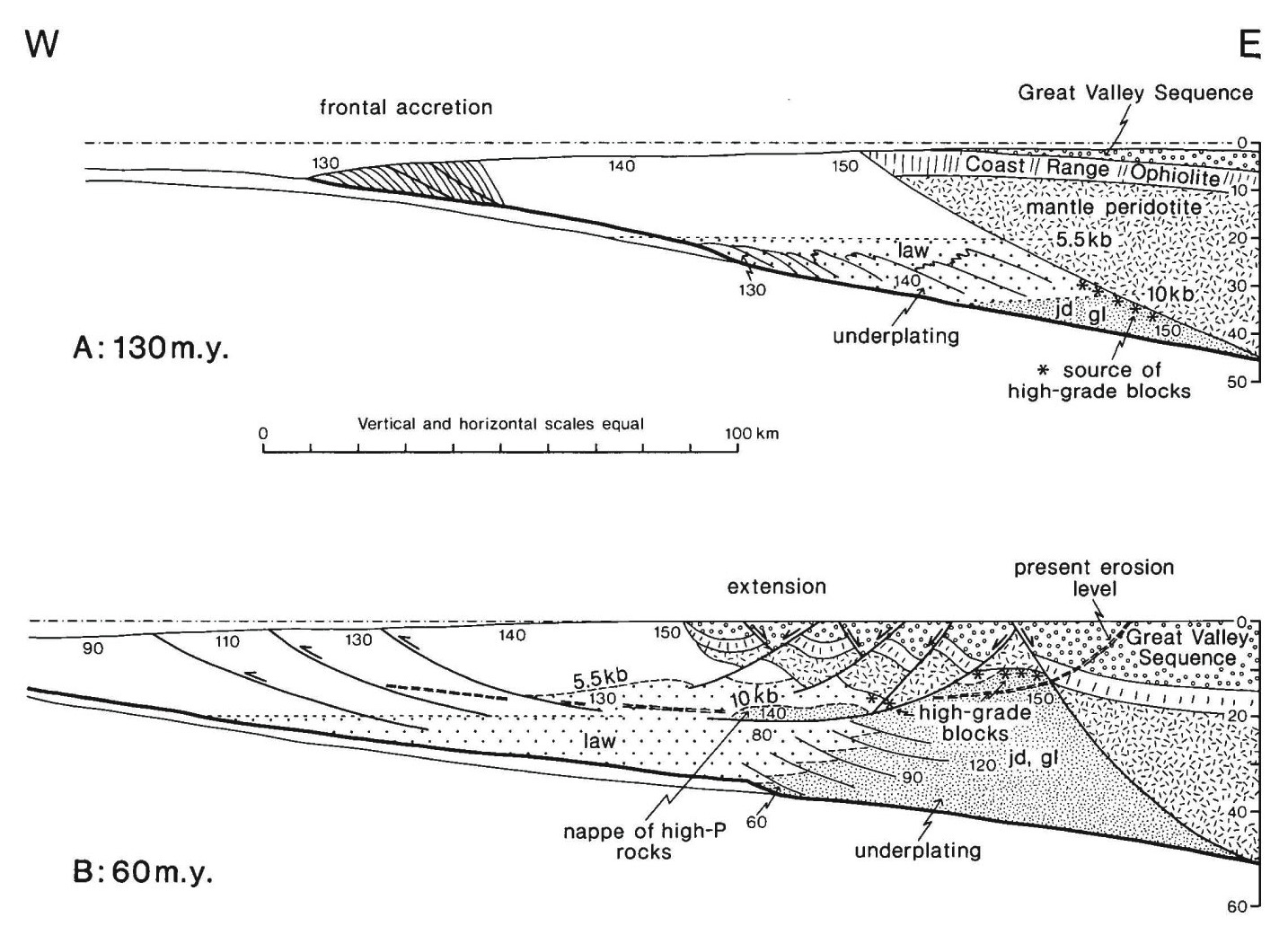


 b.
b. 


 b.
b. 






